University Nursing Assignment: Childhood Asthma in Redbridge, UK
VerifiedAdded on 2020/05/16
|19
|5006
|198
Report
AI Summary
This nursing assignment delves into the critical issue of childhood asthma within the Redbridge borough of London, UK. It begins with an introduction to community health needs assessments and highlights the prevalence of asthma, particularly among children in Redbridge. The report then explores the demographic and epidemiological factors contributing to childhood asthma in the area, emphasizing the impact of socioeconomic status, age, gender, and maternal health. It proceeds to examine the community services available in Redbridge for asthma management, including NHS provisions and children's centers. A core element of the assignment is a health needs assessment (HNA) for childhood asthma in Redbridge, using Maslow's hierarchy of needs to analyze the physical, social, and psychological needs of affected children. The report also discusses the role of nurses in empowering children with asthma and the impact of current legislation and partnership working. The assignment concludes with a critical analysis of the identified health needs and potential interventions to improve outcomes for children with asthma in Redbridge.
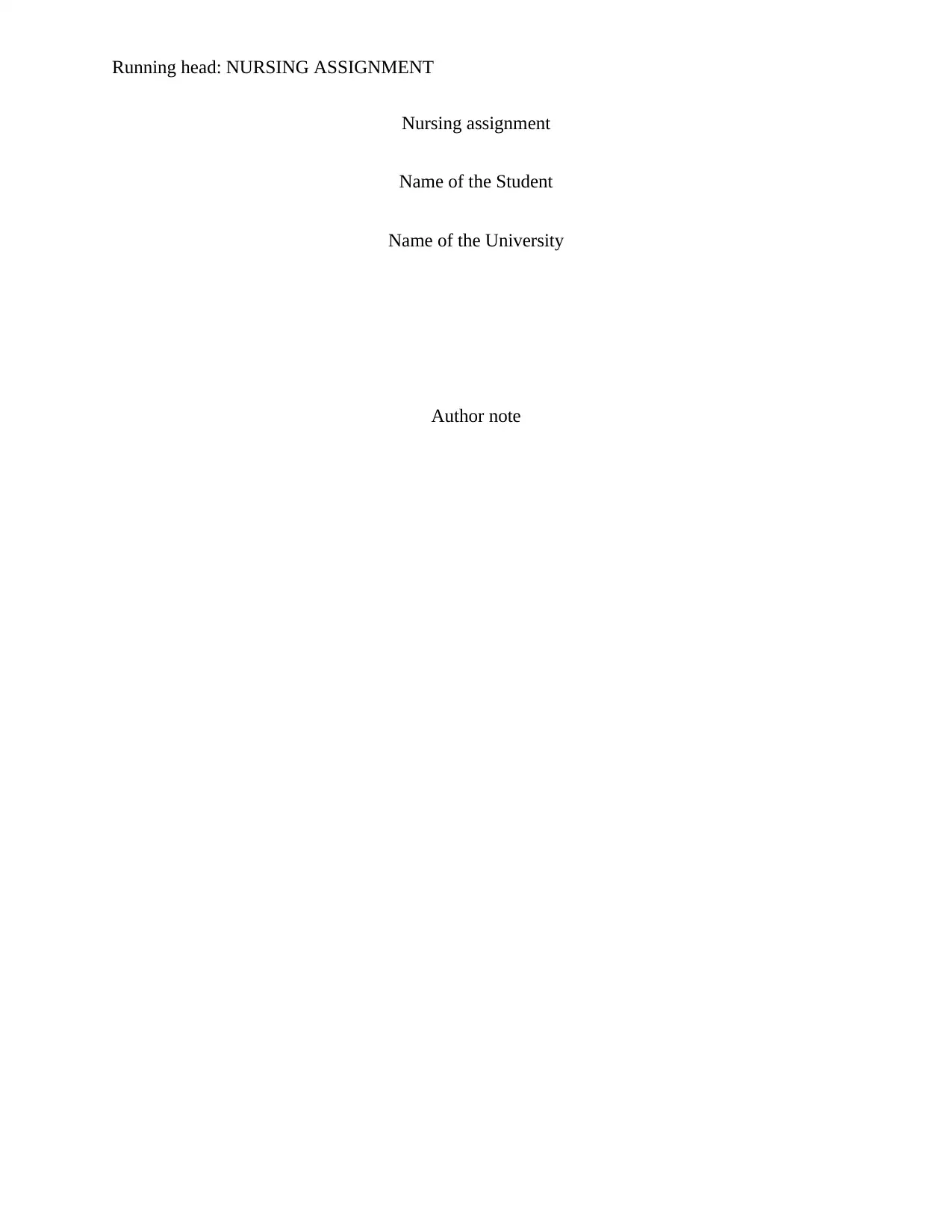
Running head: NURSING ASSIGNMENT
Nursing assignment
Name of the Student
Name of the University
Author note
Nursing assignment
Name of the Student
Name of the University
Author note
Paraphrase This Document
Need a fresh take? Get an instant paraphrase of this document with our AI Paraphraser
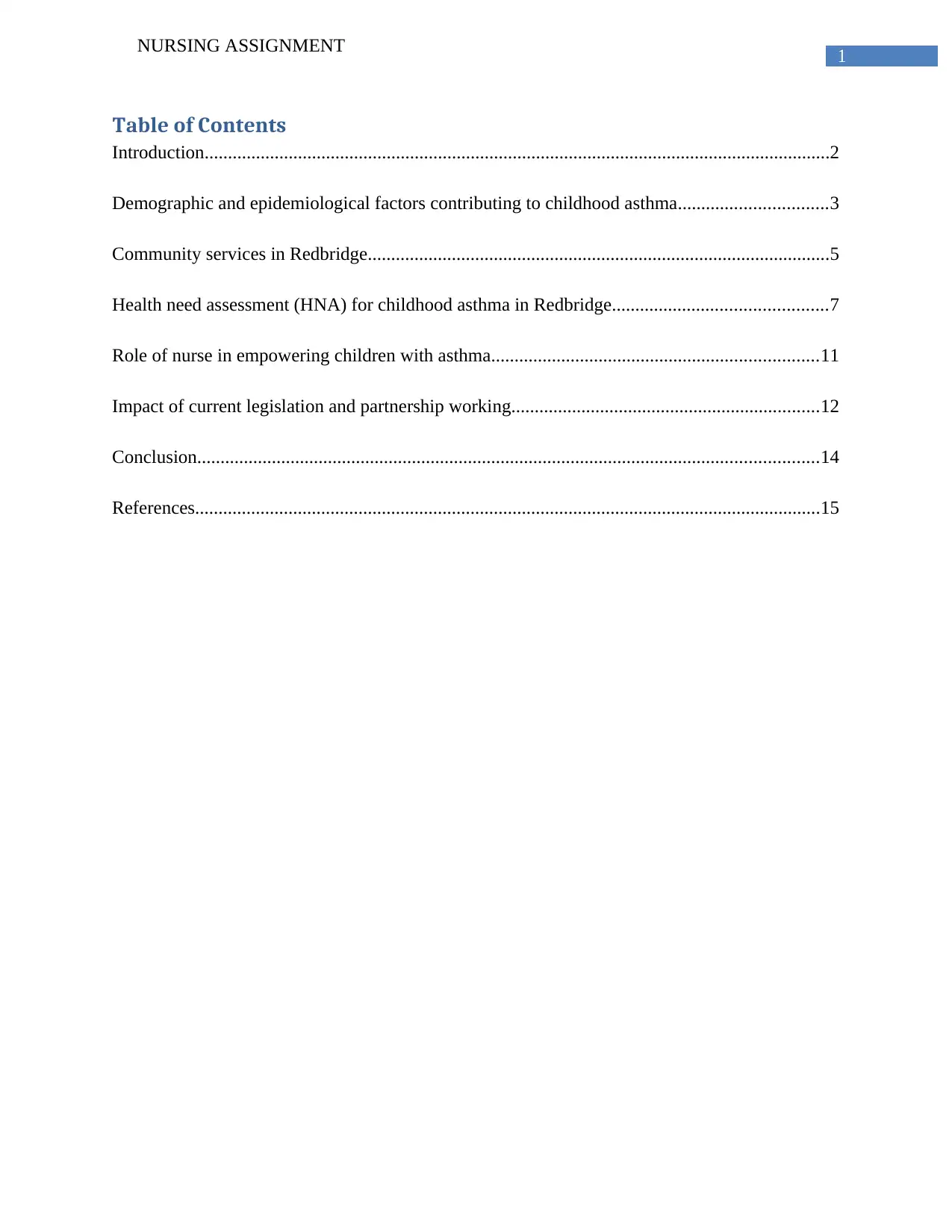
1
NURSING ASSIGNMENT
Table of Contents
Introduction......................................................................................................................................2
Demographic and epidemiological factors contributing to childhood asthma................................3
Community services in Redbridge...................................................................................................5
Health need assessment (HNA) for childhood asthma in Redbridge..............................................7
Role of nurse in empowering children with asthma......................................................................11
Impact of current legislation and partnership working..................................................................12
Conclusion.....................................................................................................................................14
References......................................................................................................................................15
NURSING ASSIGNMENT
Table of Contents
Introduction......................................................................................................................................2
Demographic and epidemiological factors contributing to childhood asthma................................3
Community services in Redbridge...................................................................................................5
Health need assessment (HNA) for childhood asthma in Redbridge..............................................7
Role of nurse in empowering children with asthma......................................................................11
Impact of current legislation and partnership working..................................................................12
Conclusion.....................................................................................................................................14
References......................................................................................................................................15
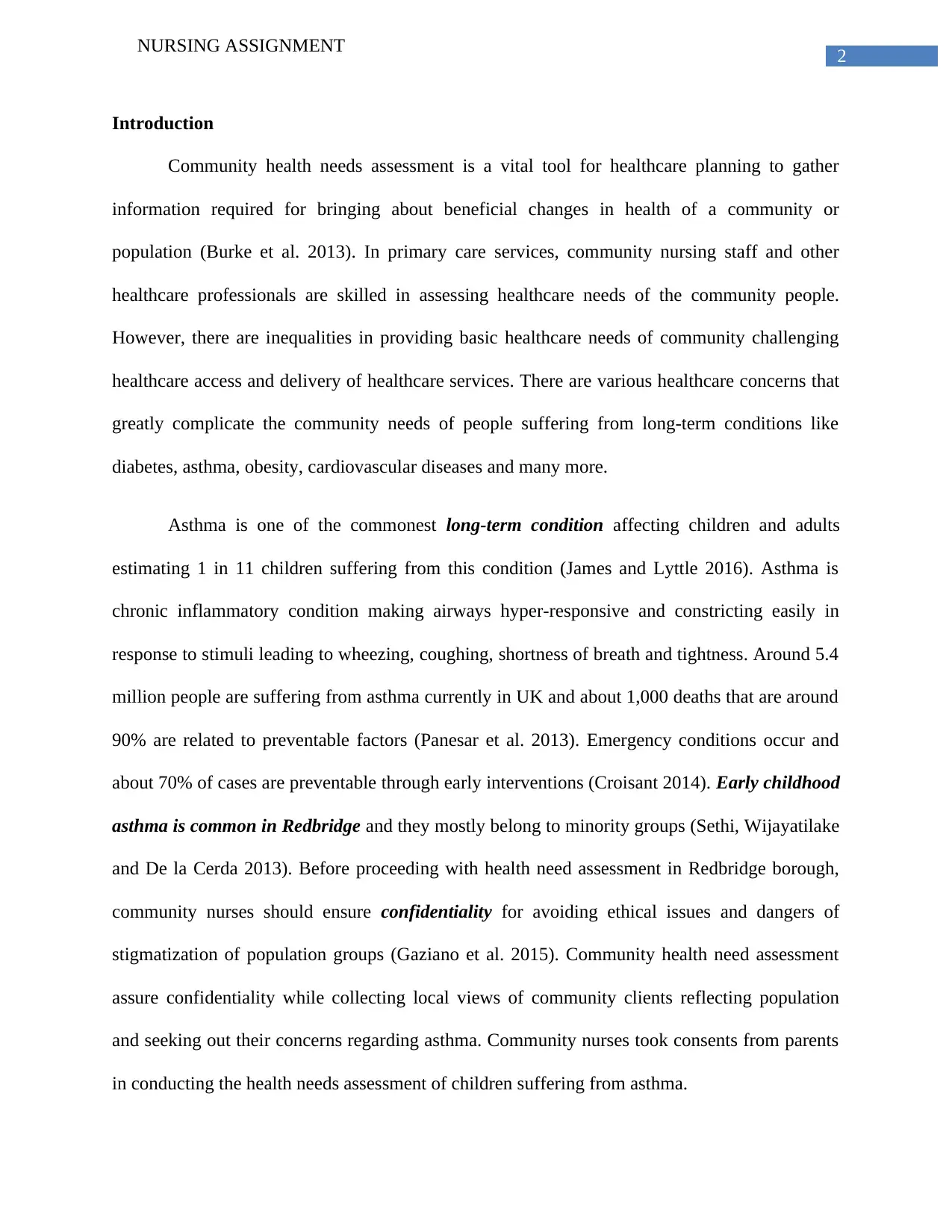
2
NURSING ASSIGNMENT
Introduction
Community health needs assessment is a vital tool for healthcare planning to gather
information required for bringing about beneficial changes in health of a community or
population (Burke et al. 2013). In primary care services, community nursing staff and other
healthcare professionals are skilled in assessing healthcare needs of the community people.
However, there are inequalities in providing basic healthcare needs of community challenging
healthcare access and delivery of healthcare services. There are various healthcare concerns that
greatly complicate the community needs of people suffering from long-term conditions like
diabetes, asthma, obesity, cardiovascular diseases and many more.
Asthma is one of the commonest long-term condition affecting children and adults
estimating 1 in 11 children suffering from this condition (James and Lyttle 2016). Asthma is
chronic inflammatory condition making airways hyper-responsive and constricting easily in
response to stimuli leading to wheezing, coughing, shortness of breath and tightness. Around 5.4
million people are suffering from asthma currently in UK and about 1,000 deaths that are around
90% are related to preventable factors (Panesar et al. 2013). Emergency conditions occur and
about 70% of cases are preventable through early interventions (Croisant 2014). Early childhood
asthma is common in Redbridge and they mostly belong to minority groups (Sethi, Wijayatilake
and De la Cerda 2013). Before proceeding with health need assessment in Redbridge borough,
community nurses should ensure confidentiality for avoiding ethical issues and dangers of
stigmatization of population groups (Gaziano et al. 2015). Community health need assessment
assure confidentiality while collecting local views of community clients reflecting population
and seeking out their concerns regarding asthma. Community nurses took consents from parents
in conducting the health needs assessment of children suffering from asthma.
NURSING ASSIGNMENT
Introduction
Community health needs assessment is a vital tool for healthcare planning to gather
information required for bringing about beneficial changes in health of a community or
population (Burke et al. 2013). In primary care services, community nursing staff and other
healthcare professionals are skilled in assessing healthcare needs of the community people.
However, there are inequalities in providing basic healthcare needs of community challenging
healthcare access and delivery of healthcare services. There are various healthcare concerns that
greatly complicate the community needs of people suffering from long-term conditions like
diabetes, asthma, obesity, cardiovascular diseases and many more.
Asthma is one of the commonest long-term condition affecting children and adults
estimating 1 in 11 children suffering from this condition (James and Lyttle 2016). Asthma is
chronic inflammatory condition making airways hyper-responsive and constricting easily in
response to stimuli leading to wheezing, coughing, shortness of breath and tightness. Around 5.4
million people are suffering from asthma currently in UK and about 1,000 deaths that are around
90% are related to preventable factors (Panesar et al. 2013). Emergency conditions occur and
about 70% of cases are preventable through early interventions (Croisant 2014). Early childhood
asthma is common in Redbridge and they mostly belong to minority groups (Sethi, Wijayatilake
and De la Cerda 2013). Before proceeding with health need assessment in Redbridge borough,
community nurses should ensure confidentiality for avoiding ethical issues and dangers of
stigmatization of population groups (Gaziano et al. 2015). Community health need assessment
assure confidentiality while collecting local views of community clients reflecting population
and seeking out their concerns regarding asthma. Community nurses took consents from parents
in conducting the health needs assessment of children suffering from asthma.
⊘ This is a preview!⊘
Do you want full access?
Subscribe today to unlock all pages.

Trusted by 1+ million students worldwide
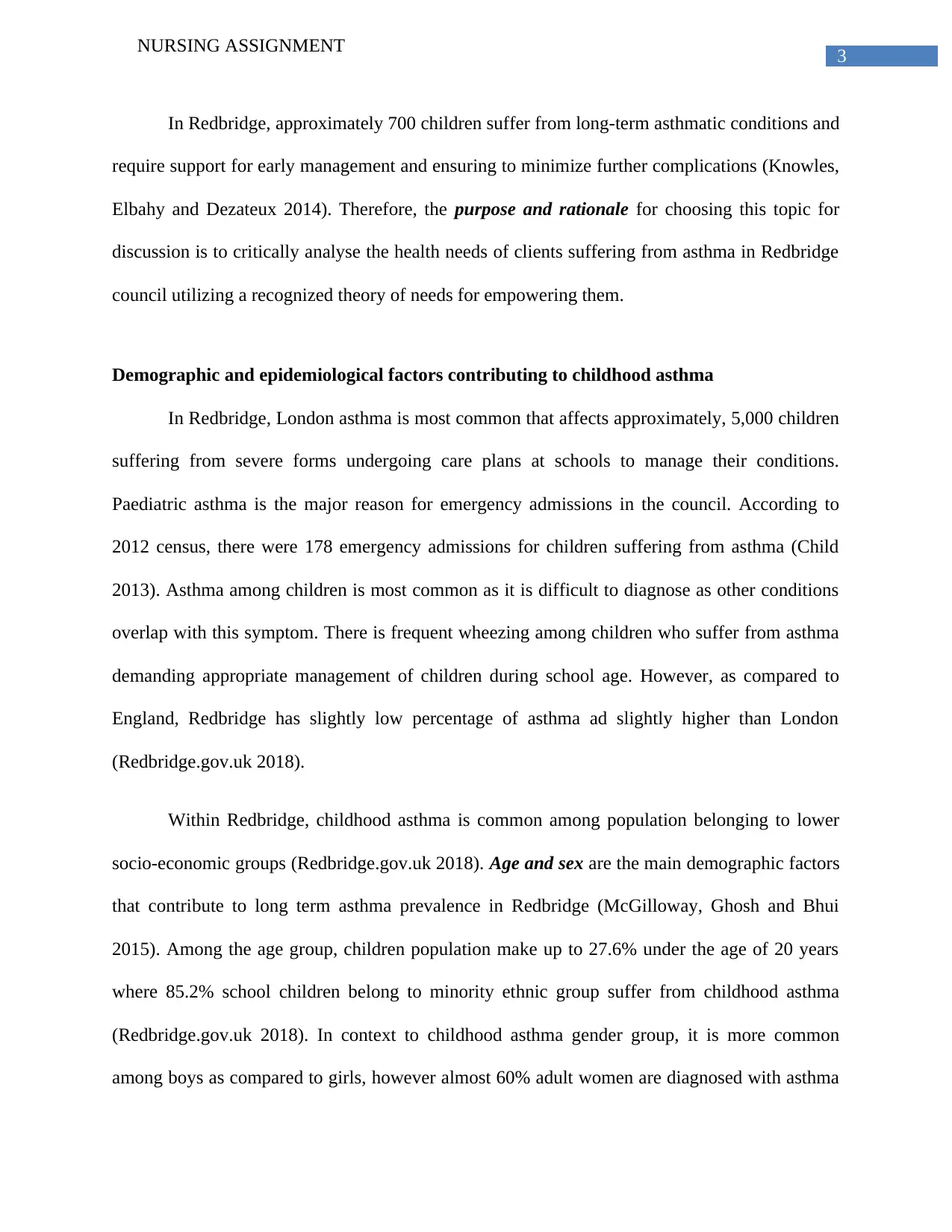
3
NURSING ASSIGNMENT
In Redbridge, approximately 700 children suffer from long-term asthmatic conditions and
require support for early management and ensuring to minimize further complications (Knowles,
Elbahy and Dezateux 2014). Therefore, the purpose and rationale for choosing this topic for
discussion is to critically analyse the health needs of clients suffering from asthma in Redbridge
council utilizing a recognized theory of needs for empowering them.
Demographic and epidemiological factors contributing to childhood asthma
In Redbridge, London asthma is most common that affects approximately, 5,000 children
suffering from severe forms undergoing care plans at schools to manage their conditions.
Paediatric asthma is the major reason for emergency admissions in the council. According to
2012 census, there were 178 emergency admissions for children suffering from asthma (Child
2013). Asthma among children is most common as it is difficult to diagnose as other conditions
overlap with this symptom. There is frequent wheezing among children who suffer from asthma
demanding appropriate management of children during school age. However, as compared to
England, Redbridge has slightly low percentage of asthma ad slightly higher than London
(Redbridge.gov.uk 2018).
Within Redbridge, childhood asthma is common among population belonging to lower
socio-economic groups (Redbridge.gov.uk 2018). Age and sex are the main demographic factors
that contribute to long term asthma prevalence in Redbridge (McGilloway, Ghosh and Bhui
2015). Among the age group, children population make up to 27.6% under the age of 20 years
where 85.2% school children belong to minority ethnic group suffer from childhood asthma
(Redbridge.gov.uk 2018). In context to childhood asthma gender group, it is more common
among boys as compared to girls, however almost 60% adult women are diagnosed with asthma
NURSING ASSIGNMENT
In Redbridge, approximately 700 children suffer from long-term asthmatic conditions and
require support for early management and ensuring to minimize further complications (Knowles,
Elbahy and Dezateux 2014). Therefore, the purpose and rationale for choosing this topic for
discussion is to critically analyse the health needs of clients suffering from asthma in Redbridge
council utilizing a recognized theory of needs for empowering them.
Demographic and epidemiological factors contributing to childhood asthma
In Redbridge, London asthma is most common that affects approximately, 5,000 children
suffering from severe forms undergoing care plans at schools to manage their conditions.
Paediatric asthma is the major reason for emergency admissions in the council. According to
2012 census, there were 178 emergency admissions for children suffering from asthma (Child
2013). Asthma among children is most common as it is difficult to diagnose as other conditions
overlap with this symptom. There is frequent wheezing among children who suffer from asthma
demanding appropriate management of children during school age. However, as compared to
England, Redbridge has slightly low percentage of asthma ad slightly higher than London
(Redbridge.gov.uk 2018).
Within Redbridge, childhood asthma is common among population belonging to lower
socio-economic groups (Redbridge.gov.uk 2018). Age and sex are the main demographic factors
that contribute to long term asthma prevalence in Redbridge (McGilloway, Ghosh and Bhui
2015). Among the age group, children population make up to 27.6% under the age of 20 years
where 85.2% school children belong to minority ethnic group suffer from childhood asthma
(Redbridge.gov.uk 2018). In context to childhood asthma gender group, it is more common
among boys as compared to girls, however almost 60% adult women are diagnosed with asthma
Paraphrase This Document
Need a fresh take? Get an instant paraphrase of this document with our AI Paraphraser
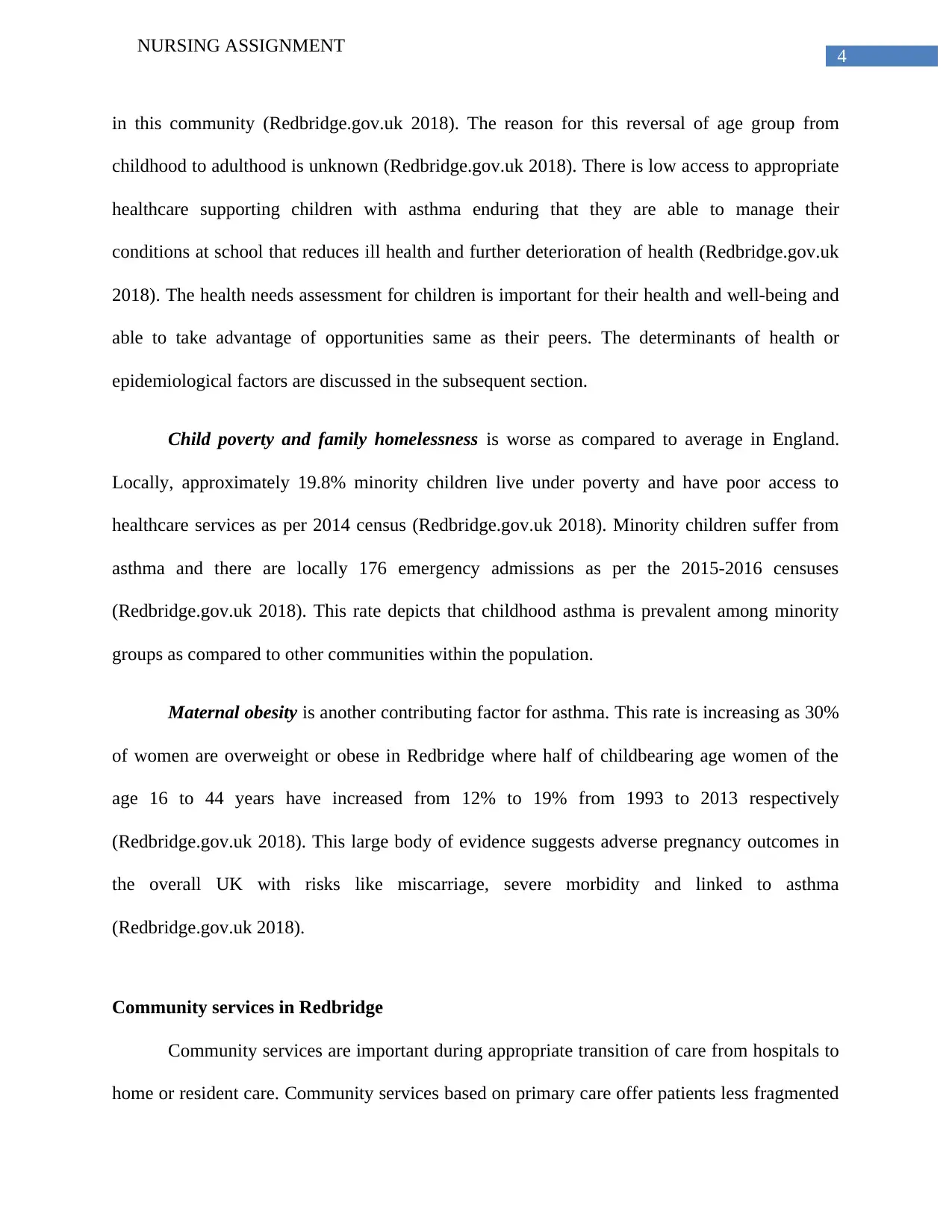
4
NURSING ASSIGNMENT
in this community (Redbridge.gov.uk 2018). The reason for this reversal of age group from
childhood to adulthood is unknown (Redbridge.gov.uk 2018). There is low access to appropriate
healthcare supporting children with asthma enduring that they are able to manage their
conditions at school that reduces ill health and further deterioration of health (Redbridge.gov.uk
2018). The health needs assessment for children is important for their health and well-being and
able to take advantage of opportunities same as their peers. The determinants of health or
epidemiological factors are discussed in the subsequent section.
Child poverty and family homelessness is worse as compared to average in England.
Locally, approximately 19.8% minority children live under poverty and have poor access to
healthcare services as per 2014 census (Redbridge.gov.uk 2018). Minority children suffer from
asthma and there are locally 176 emergency admissions as per the 2015-2016 censuses
(Redbridge.gov.uk 2018). This rate depicts that childhood asthma is prevalent among minority
groups as compared to other communities within the population.
Maternal obesity is another contributing factor for asthma. This rate is increasing as 30%
of women are overweight or obese in Redbridge where half of childbearing age women of the
age 16 to 44 years have increased from 12% to 19% from 1993 to 2013 respectively
(Redbridge.gov.uk 2018). This large body of evidence suggests adverse pregnancy outcomes in
the overall UK with risks like miscarriage, severe morbidity and linked to asthma
(Redbridge.gov.uk 2018).
Community services in Redbridge
Community services are important during appropriate transition of care from hospitals to
home or resident care. Community services based on primary care offer patients less fragmented
NURSING ASSIGNMENT
in this community (Redbridge.gov.uk 2018). The reason for this reversal of age group from
childhood to adulthood is unknown (Redbridge.gov.uk 2018). There is low access to appropriate
healthcare supporting children with asthma enduring that they are able to manage their
conditions at school that reduces ill health and further deterioration of health (Redbridge.gov.uk
2018). The health needs assessment for children is important for their health and well-being and
able to take advantage of opportunities same as their peers. The determinants of health or
epidemiological factors are discussed in the subsequent section.
Child poverty and family homelessness is worse as compared to average in England.
Locally, approximately 19.8% minority children live under poverty and have poor access to
healthcare services as per 2014 census (Redbridge.gov.uk 2018). Minority children suffer from
asthma and there are locally 176 emergency admissions as per the 2015-2016 censuses
(Redbridge.gov.uk 2018). This rate depicts that childhood asthma is prevalent among minority
groups as compared to other communities within the population.
Maternal obesity is another contributing factor for asthma. This rate is increasing as 30%
of women are overweight or obese in Redbridge where half of childbearing age women of the
age 16 to 44 years have increased from 12% to 19% from 1993 to 2013 respectively
(Redbridge.gov.uk 2018). This large body of evidence suggests adverse pregnancy outcomes in
the overall UK with risks like miscarriage, severe morbidity and linked to asthma
(Redbridge.gov.uk 2018).
Community services in Redbridge
Community services are important during appropriate transition of care from hospitals to
home or resident care. Community services based on primary care offer patients less fragmented
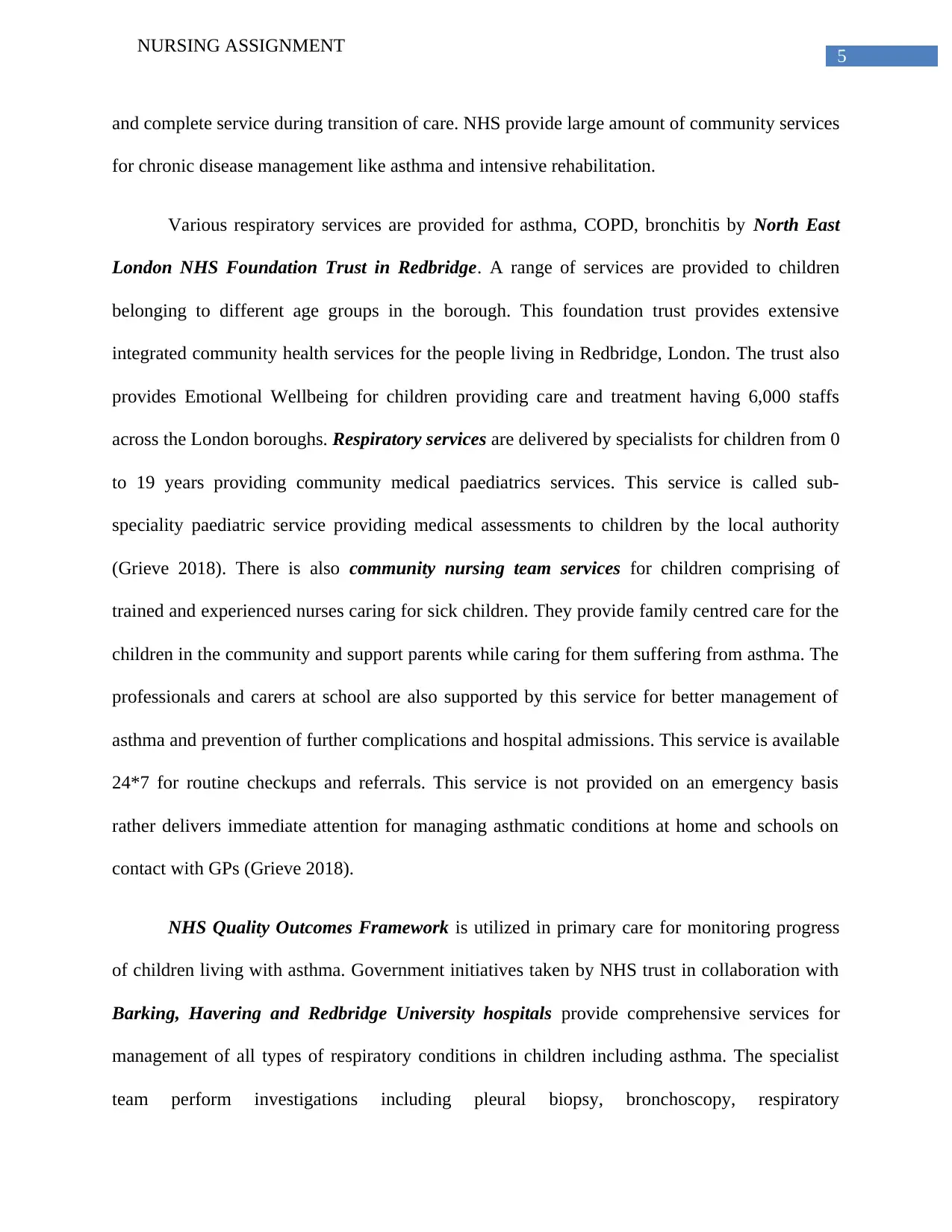
5
NURSING ASSIGNMENT
and complete service during transition of care. NHS provide large amount of community services
for chronic disease management like asthma and intensive rehabilitation.
Various respiratory services are provided for asthma, COPD, bronchitis by North East
London NHS Foundation Trust in Redbridge. A range of services are provided to children
belonging to different age groups in the borough. This foundation trust provides extensive
integrated community health services for the people living in Redbridge, London. The trust also
provides Emotional Wellbeing for children providing care and treatment having 6,000 staffs
across the London boroughs. Respiratory services are delivered by specialists for children from 0
to 19 years providing community medical paediatrics services. This service is called sub-
speciality paediatric service providing medical assessments to children by the local authority
(Grieve 2018). There is also community nursing team services for children comprising of
trained and experienced nurses caring for sick children. They provide family centred care for the
children in the community and support parents while caring for them suffering from asthma. The
professionals and carers at school are also supported by this service for better management of
asthma and prevention of further complications and hospital admissions. This service is available
24*7 for routine checkups and referrals. This service is not provided on an emergency basis
rather delivers immediate attention for managing asthmatic conditions at home and schools on
contact with GPs (Grieve 2018).
NHS Quality Outcomes Framework is utilized in primary care for monitoring progress
of children living with asthma. Government initiatives taken by NHS trust in collaboration with
Barking, Havering and Redbridge University hospitals provide comprehensive services for
management of all types of respiratory conditions in children including asthma. The specialist
team perform investigations including pleural biopsy, bronchoscopy, respiratory
NURSING ASSIGNMENT
and complete service during transition of care. NHS provide large amount of community services
for chronic disease management like asthma and intensive rehabilitation.
Various respiratory services are provided for asthma, COPD, bronchitis by North East
London NHS Foundation Trust in Redbridge. A range of services are provided to children
belonging to different age groups in the borough. This foundation trust provides extensive
integrated community health services for the people living in Redbridge, London. The trust also
provides Emotional Wellbeing for children providing care and treatment having 6,000 staffs
across the London boroughs. Respiratory services are delivered by specialists for children from 0
to 19 years providing community medical paediatrics services. This service is called sub-
speciality paediatric service providing medical assessments to children by the local authority
(Grieve 2018). There is also community nursing team services for children comprising of
trained and experienced nurses caring for sick children. They provide family centred care for the
children in the community and support parents while caring for them suffering from asthma. The
professionals and carers at school are also supported by this service for better management of
asthma and prevention of further complications and hospital admissions. This service is available
24*7 for routine checkups and referrals. This service is not provided on an emergency basis
rather delivers immediate attention for managing asthmatic conditions at home and schools on
contact with GPs (Grieve 2018).
NHS Quality Outcomes Framework is utilized in primary care for monitoring progress
of children living with asthma. Government initiatives taken by NHS trust in collaboration with
Barking, Havering and Redbridge University hospitals provide comprehensive services for
management of all types of respiratory conditions in children including asthma. The specialist
team perform investigations including pleural biopsy, bronchoscopy, respiratory
⊘ This is a preview!⊘
Do you want full access?
Subscribe today to unlock all pages.

Trusted by 1+ million students worldwide
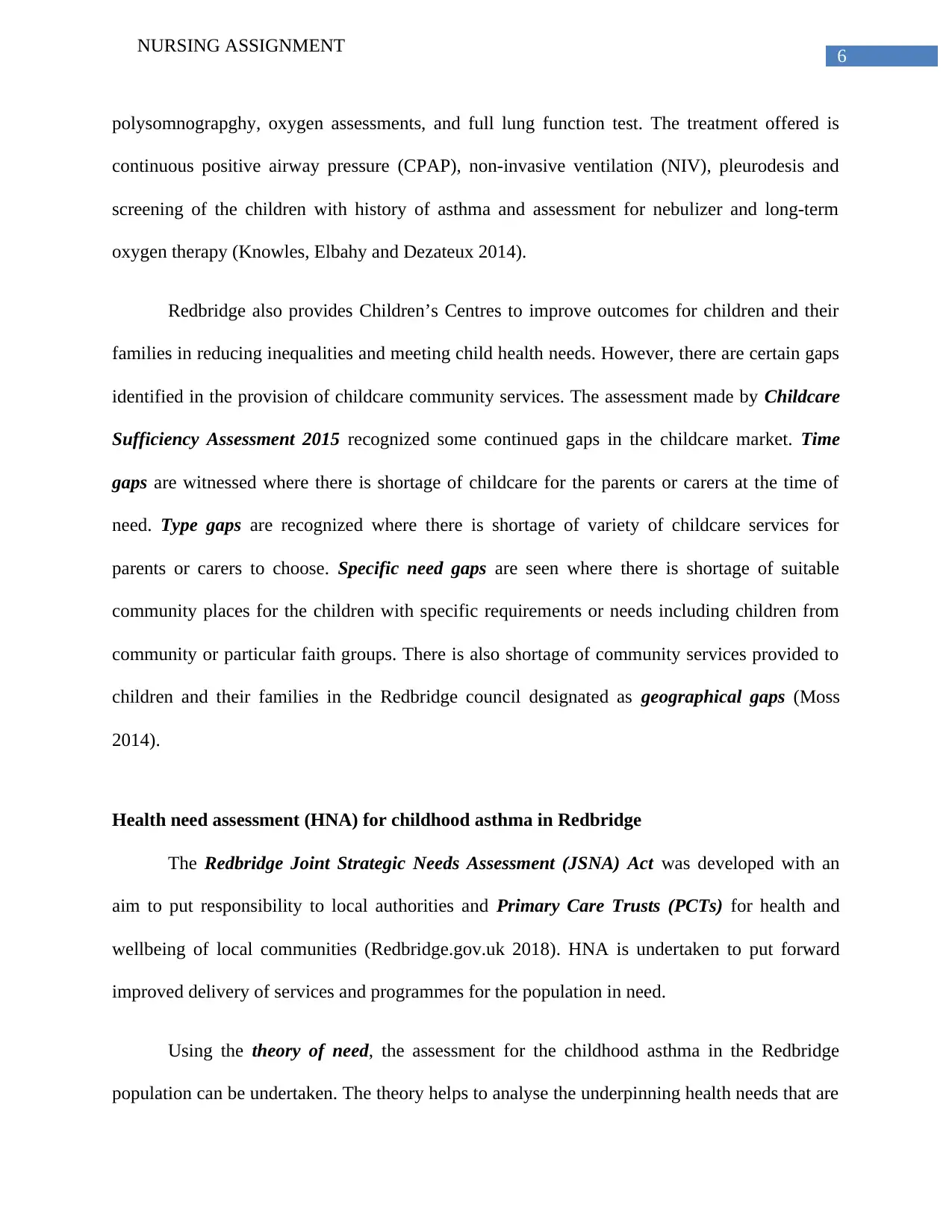
6
NURSING ASSIGNMENT
polysomnograpghy, oxygen assessments, and full lung function test. The treatment offered is
continuous positive airway pressure (CPAP), non-invasive ventilation (NIV), pleurodesis and
screening of the children with history of asthma and assessment for nebulizer and long-term
oxygen therapy (Knowles, Elbahy and Dezateux 2014).
Redbridge also provides Children’s Centres to improve outcomes for children and their
families in reducing inequalities and meeting child health needs. However, there are certain gaps
identified in the provision of childcare community services. The assessment made by Childcare
Sufficiency Assessment 2015 recognized some continued gaps in the childcare market. Time
gaps are witnessed where there is shortage of childcare for the parents or carers at the time of
need. Type gaps are recognized where there is shortage of variety of childcare services for
parents or carers to choose. Specific need gaps are seen where there is shortage of suitable
community places for the children with specific requirements or needs including children from
community or particular faith groups. There is also shortage of community services provided to
children and their families in the Redbridge council designated as geographical gaps (Moss
2014).
Health need assessment (HNA) for childhood asthma in Redbridge
The Redbridge Joint Strategic Needs Assessment (JSNA) Act was developed with an
aim to put responsibility to local authorities and Primary Care Trusts (PCTs) for health and
wellbeing of local communities (Redbridge.gov.uk 2018). HNA is undertaken to put forward
improved delivery of services and programmes for the population in need.
Using the theory of need, the assessment for the childhood asthma in the Redbridge
population can be undertaken. The theory helps to analyse the underpinning health needs that are
NURSING ASSIGNMENT
polysomnograpghy, oxygen assessments, and full lung function test. The treatment offered is
continuous positive airway pressure (CPAP), non-invasive ventilation (NIV), pleurodesis and
screening of the children with history of asthma and assessment for nebulizer and long-term
oxygen therapy (Knowles, Elbahy and Dezateux 2014).
Redbridge also provides Children’s Centres to improve outcomes for children and their
families in reducing inequalities and meeting child health needs. However, there are certain gaps
identified in the provision of childcare community services. The assessment made by Childcare
Sufficiency Assessment 2015 recognized some continued gaps in the childcare market. Time
gaps are witnessed where there is shortage of childcare for the parents or carers at the time of
need. Type gaps are recognized where there is shortage of variety of childcare services for
parents or carers to choose. Specific need gaps are seen where there is shortage of suitable
community places for the children with specific requirements or needs including children from
community or particular faith groups. There is also shortage of community services provided to
children and their families in the Redbridge council designated as geographical gaps (Moss
2014).
Health need assessment (HNA) for childhood asthma in Redbridge
The Redbridge Joint Strategic Needs Assessment (JSNA) Act was developed with an
aim to put responsibility to local authorities and Primary Care Trusts (PCTs) for health and
wellbeing of local communities (Redbridge.gov.uk 2018). HNA is undertaken to put forward
improved delivery of services and programmes for the population in need.
Using the theory of need, the assessment for the childhood asthma in the Redbridge
population can be undertaken. The theory helps to analyse the underpinning health needs that are
Paraphrase This Document
Need a fresh take? Get an instant paraphrase of this document with our AI Paraphraser
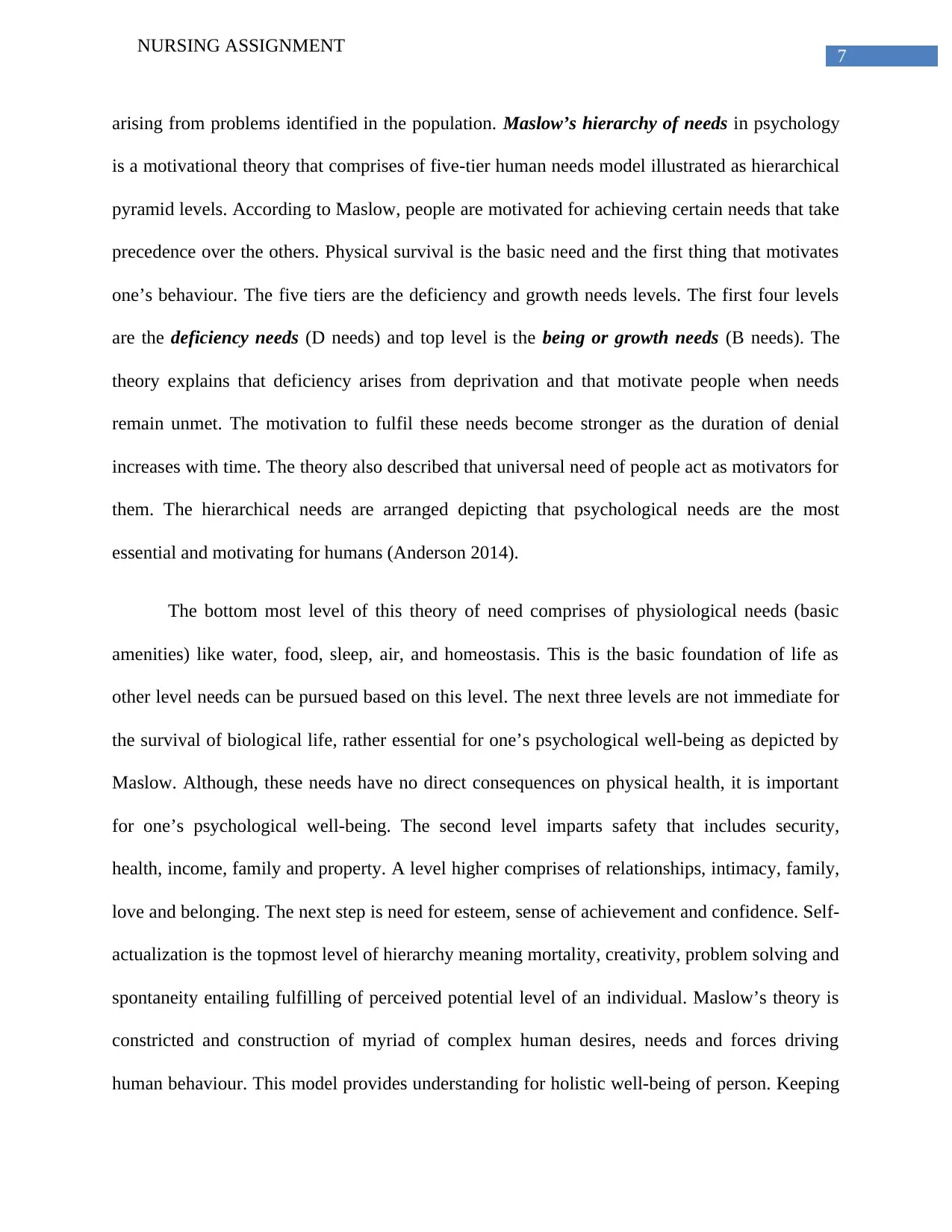
7
NURSING ASSIGNMENT
arising from problems identified in the population. Maslow’s hierarchy of needs in psychology
is a motivational theory that comprises of five-tier human needs model illustrated as hierarchical
pyramid levels. According to Maslow, people are motivated for achieving certain needs that take
precedence over the others. Physical survival is the basic need and the first thing that motivates
one’s behaviour. The five tiers are the deficiency and growth needs levels. The first four levels
are the deficiency needs (D needs) and top level is the being or growth needs (B needs). The
theory explains that deficiency arises from deprivation and that motivate people when needs
remain unmet. The motivation to fulfil these needs become stronger as the duration of denial
increases with time. The theory also described that universal need of people act as motivators for
them. The hierarchical needs are arranged depicting that psychological needs are the most
essential and motivating for humans (Anderson 2014).
The bottom most level of this theory of need comprises of physiological needs (basic
amenities) like water, food, sleep, air, and homeostasis. This is the basic foundation of life as
other level needs can be pursued based on this level. The next three levels are not immediate for
the survival of biological life, rather essential for one’s psychological well-being as depicted by
Maslow. Although, these needs have no direct consequences on physical health, it is important
for one’s psychological well-being. The second level imparts safety that includes security,
health, income, family and property. A level higher comprises of relationships, intimacy, family,
love and belonging. The next step is need for esteem, sense of achievement and confidence. Self-
actualization is the topmost level of hierarchy meaning mortality, creativity, problem solving and
spontaneity entailing fulfilling of perceived potential level of an individual. Maslow’s theory is
constricted and construction of myriad of complex human desires, needs and forces driving
human behaviour. This model provides understanding for holistic well-being of person. Keeping
NURSING ASSIGNMENT
arising from problems identified in the population. Maslow’s hierarchy of needs in psychology
is a motivational theory that comprises of five-tier human needs model illustrated as hierarchical
pyramid levels. According to Maslow, people are motivated for achieving certain needs that take
precedence over the others. Physical survival is the basic need and the first thing that motivates
one’s behaviour. The five tiers are the deficiency and growth needs levels. The first four levels
are the deficiency needs (D needs) and top level is the being or growth needs (B needs). The
theory explains that deficiency arises from deprivation and that motivate people when needs
remain unmet. The motivation to fulfil these needs become stronger as the duration of denial
increases with time. The theory also described that universal need of people act as motivators for
them. The hierarchical needs are arranged depicting that psychological needs are the most
essential and motivating for humans (Anderson 2014).
The bottom most level of this theory of need comprises of physiological needs (basic
amenities) like water, food, sleep, air, and homeostasis. This is the basic foundation of life as
other level needs can be pursued based on this level. The next three levels are not immediate for
the survival of biological life, rather essential for one’s psychological well-being as depicted by
Maslow. Although, these needs have no direct consequences on physical health, it is important
for one’s psychological well-being. The second level imparts safety that includes security,
health, income, family and property. A level higher comprises of relationships, intimacy, family,
love and belonging. The next step is need for esteem, sense of achievement and confidence. Self-
actualization is the topmost level of hierarchy meaning mortality, creativity, problem solving and
spontaneity entailing fulfilling of perceived potential level of an individual. Maslow’s theory is
constricted and construction of myriad of complex human desires, needs and forces driving
human behaviour. This model provides understanding for holistic well-being of person. Keeping
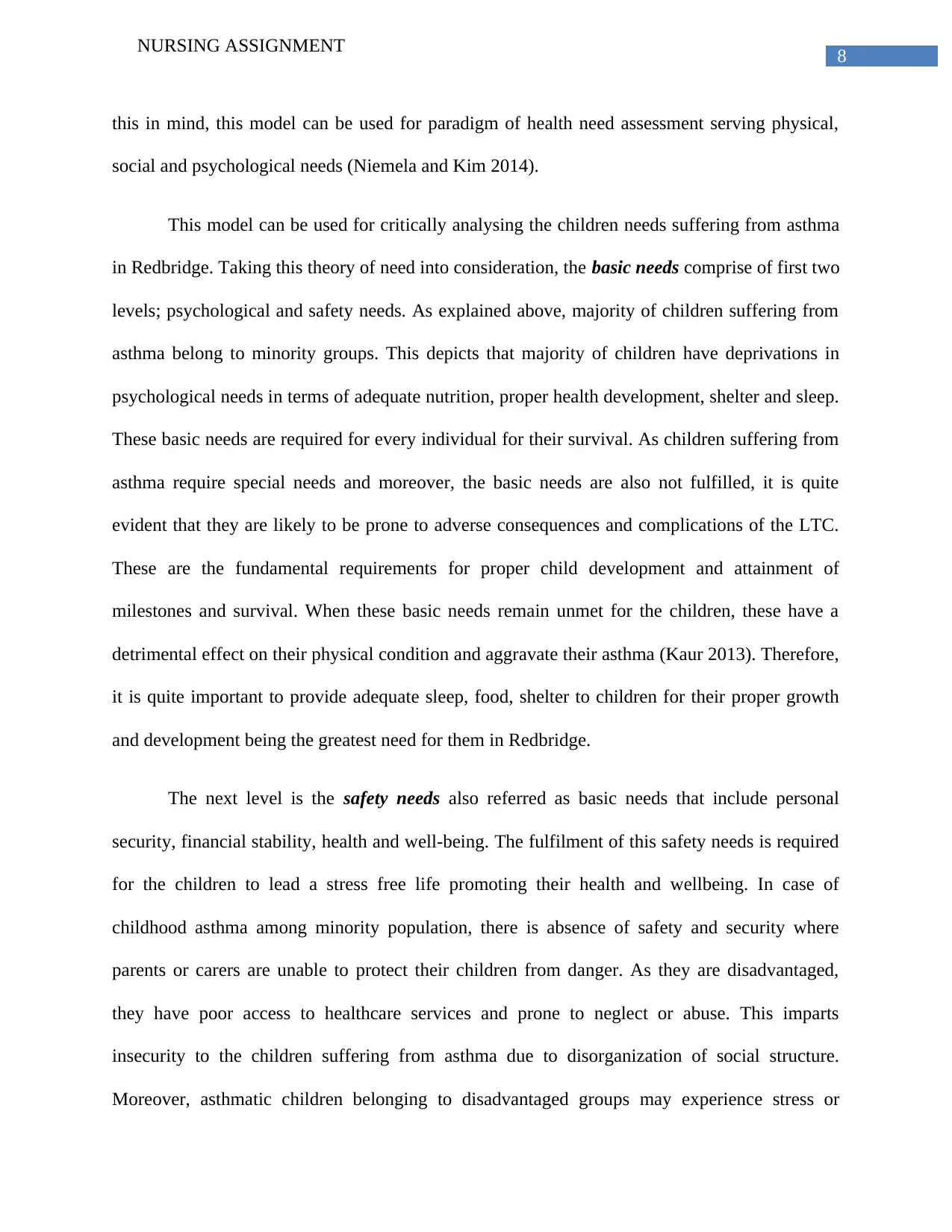
8
NURSING ASSIGNMENT
this in mind, this model can be used for paradigm of health need assessment serving physical,
social and psychological needs (Niemela and Kim 2014).
This model can be used for critically analysing the children needs suffering from asthma
in Redbridge. Taking this theory of need into consideration, the basic needs comprise of first two
levels; psychological and safety needs. As explained above, majority of children suffering from
asthma belong to minority groups. This depicts that majority of children have deprivations in
psychological needs in terms of adequate nutrition, proper health development, shelter and sleep.
These basic needs are required for every individual for their survival. As children suffering from
asthma require special needs and moreover, the basic needs are also not fulfilled, it is quite
evident that they are likely to be prone to adverse consequences and complications of the LTC.
These are the fundamental requirements for proper child development and attainment of
milestones and survival. When these basic needs remain unmet for the children, these have a
detrimental effect on their physical condition and aggravate their asthma (Kaur 2013). Therefore,
it is quite important to provide adequate sleep, food, shelter to children for their proper growth
and development being the greatest need for them in Redbridge.
The next level is the safety needs also referred as basic needs that include personal
security, financial stability, health and well-being. The fulfilment of this safety needs is required
for the children to lead a stress free life promoting their health and wellbeing. In case of
childhood asthma among minority population, there is absence of safety and security where
parents or carers are unable to protect their children from danger. As they are disadvantaged,
they have poor access to healthcare services and prone to neglect or abuse. This imparts
insecurity to the children suffering from asthma due to disorganization of social structure.
Moreover, asthmatic children belonging to disadvantaged groups may experience stress or
NURSING ASSIGNMENT
this in mind, this model can be used for paradigm of health need assessment serving physical,
social and psychological needs (Niemela and Kim 2014).
This model can be used for critically analysing the children needs suffering from asthma
in Redbridge. Taking this theory of need into consideration, the basic needs comprise of first two
levels; psychological and safety needs. As explained above, majority of children suffering from
asthma belong to minority groups. This depicts that majority of children have deprivations in
psychological needs in terms of adequate nutrition, proper health development, shelter and sleep.
These basic needs are required for every individual for their survival. As children suffering from
asthma require special needs and moreover, the basic needs are also not fulfilled, it is quite
evident that they are likely to be prone to adverse consequences and complications of the LTC.
These are the fundamental requirements for proper child development and attainment of
milestones and survival. When these basic needs remain unmet for the children, these have a
detrimental effect on their physical condition and aggravate their asthma (Kaur 2013). Therefore,
it is quite important to provide adequate sleep, food, shelter to children for their proper growth
and development being the greatest need for them in Redbridge.
The next level is the safety needs also referred as basic needs that include personal
security, financial stability, health and well-being. The fulfilment of this safety needs is required
for the children to lead a stress free life promoting their health and wellbeing. In case of
childhood asthma among minority population, there is absence of safety and security where
parents or carers are unable to protect their children from danger. As they are disadvantaged,
they have poor access to healthcare services and prone to neglect or abuse. This imparts
insecurity to the children suffering from asthma due to disorganization of social structure.
Moreover, asthmatic children belonging to disadvantaged groups may experience stress or
⊘ This is a preview!⊘
Do you want full access?
Subscribe today to unlock all pages.

Trusted by 1+ million students worldwide
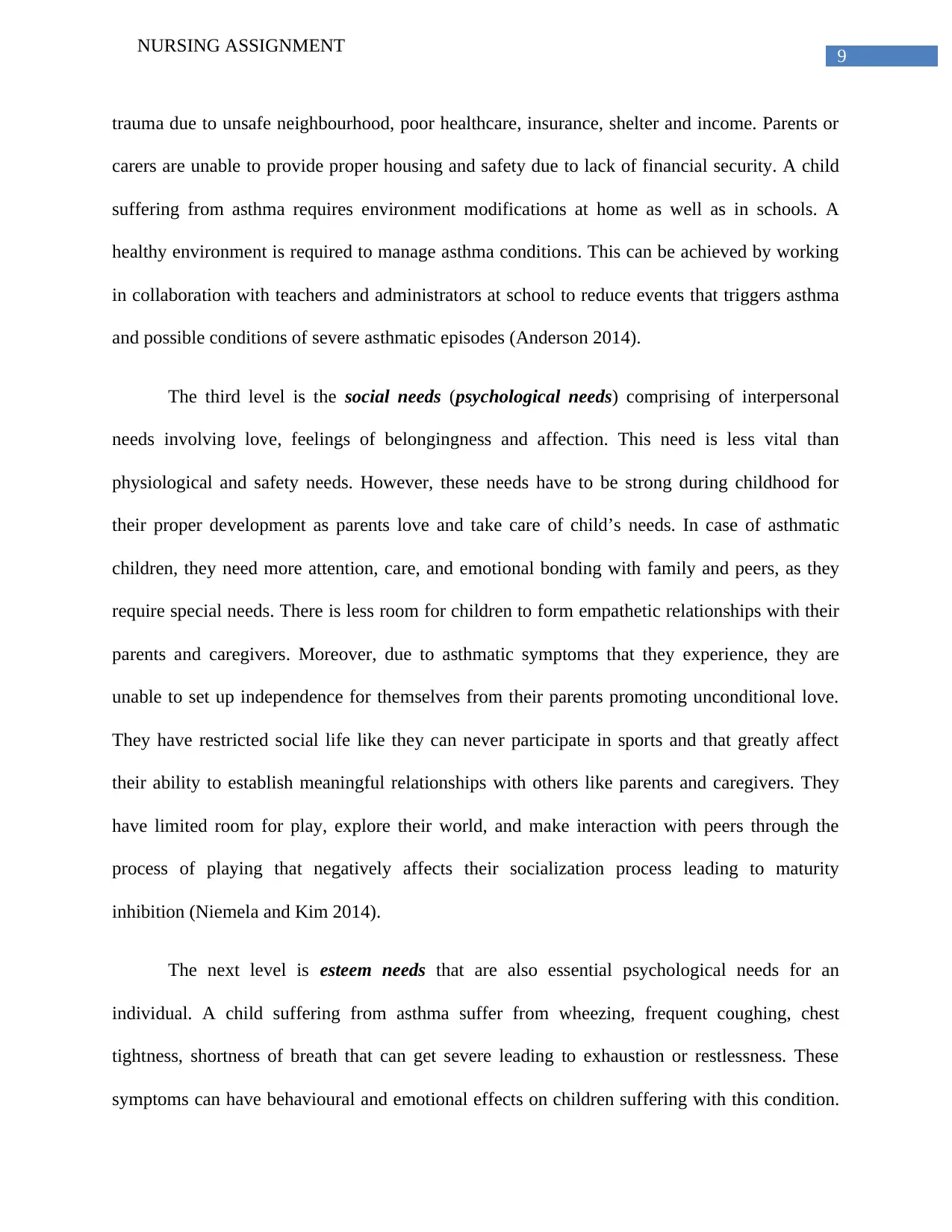
9
NURSING ASSIGNMENT
trauma due to unsafe neighbourhood, poor healthcare, insurance, shelter and income. Parents or
carers are unable to provide proper housing and safety due to lack of financial security. A child
suffering from asthma requires environment modifications at home as well as in schools. A
healthy environment is required to manage asthma conditions. This can be achieved by working
in collaboration with teachers and administrators at school to reduce events that triggers asthma
and possible conditions of severe asthmatic episodes (Anderson 2014).
The third level is the social needs (psychological needs) comprising of interpersonal
needs involving love, feelings of belongingness and affection. This need is less vital than
physiological and safety needs. However, these needs have to be strong during childhood for
their proper development as parents love and take care of child’s needs. In case of asthmatic
children, they need more attention, care, and emotional bonding with family and peers, as they
require special needs. There is less room for children to form empathetic relationships with their
parents and caregivers. Moreover, due to asthmatic symptoms that they experience, they are
unable to set up independence for themselves from their parents promoting unconditional love.
They have restricted social life like they can never participate in sports and that greatly affect
their ability to establish meaningful relationships with others like parents and caregivers. They
have limited room for play, explore their world, and make interaction with peers through the
process of playing that negatively affects their socialization process leading to maturity
inhibition (Niemela and Kim 2014).
The next level is esteem needs that are also essential psychological needs for an
individual. A child suffering from asthma suffer from wheezing, frequent coughing, chest
tightness, shortness of breath that can get severe leading to exhaustion or restlessness. These
symptoms can have behavioural and emotional effects on children suffering with this condition.
NURSING ASSIGNMENT
trauma due to unsafe neighbourhood, poor healthcare, insurance, shelter and income. Parents or
carers are unable to provide proper housing and safety due to lack of financial security. A child
suffering from asthma requires environment modifications at home as well as in schools. A
healthy environment is required to manage asthma conditions. This can be achieved by working
in collaboration with teachers and administrators at school to reduce events that triggers asthma
and possible conditions of severe asthmatic episodes (Anderson 2014).
The third level is the social needs (psychological needs) comprising of interpersonal
needs involving love, feelings of belongingness and affection. This need is less vital than
physiological and safety needs. However, these needs have to be strong during childhood for
their proper development as parents love and take care of child’s needs. In case of asthmatic
children, they need more attention, care, and emotional bonding with family and peers, as they
require special needs. There is less room for children to form empathetic relationships with their
parents and caregivers. Moreover, due to asthmatic symptoms that they experience, they are
unable to set up independence for themselves from their parents promoting unconditional love.
They have restricted social life like they can never participate in sports and that greatly affect
their ability to establish meaningful relationships with others like parents and caregivers. They
have limited room for play, explore their world, and make interaction with peers through the
process of playing that negatively affects their socialization process leading to maturity
inhibition (Niemela and Kim 2014).
The next level is esteem needs that are also essential psychological needs for an
individual. A child suffering from asthma suffer from wheezing, frequent coughing, chest
tightness, shortness of breath that can get severe leading to exhaustion or restlessness. These
symptoms can have behavioural and emotional effects on children suffering with this condition.
Paraphrase This Document
Need a fresh take? Get an instant paraphrase of this document with our AI Paraphraser
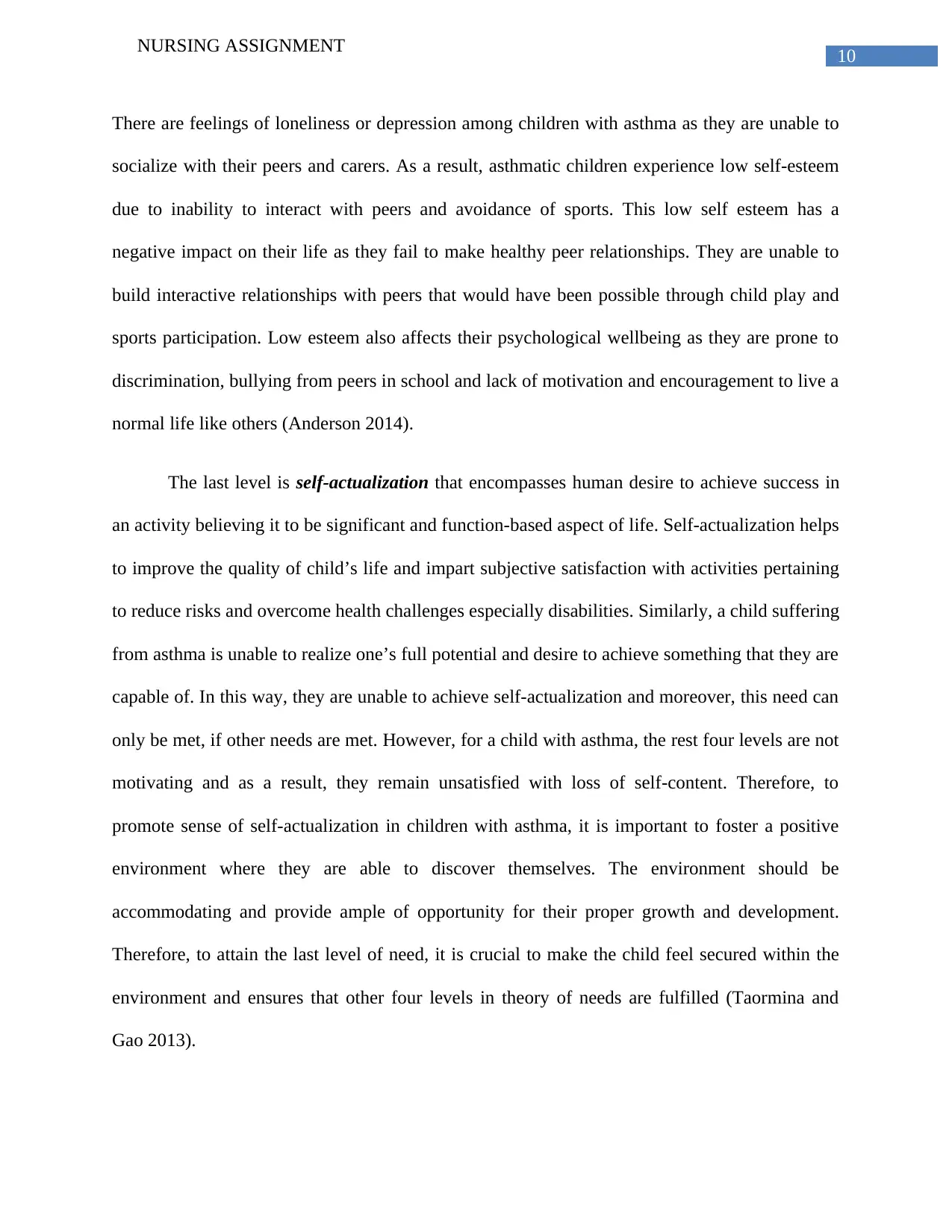
10
NURSING ASSIGNMENT
There are feelings of loneliness or depression among children with asthma as they are unable to
socialize with their peers and carers. As a result, asthmatic children experience low self-esteem
due to inability to interact with peers and avoidance of sports. This low self esteem has a
negative impact on their life as they fail to make healthy peer relationships. They are unable to
build interactive relationships with peers that would have been possible through child play and
sports participation. Low esteem also affects their psychological wellbeing as they are prone to
discrimination, bullying from peers in school and lack of motivation and encouragement to live a
normal life like others (Anderson 2014).
The last level is self-actualization that encompasses human desire to achieve success in
an activity believing it to be significant and function-based aspect of life. Self-actualization helps
to improve the quality of child’s life and impart subjective satisfaction with activities pertaining
to reduce risks and overcome health challenges especially disabilities. Similarly, a child suffering
from asthma is unable to realize one’s full potential and desire to achieve something that they are
capable of. In this way, they are unable to achieve self-actualization and moreover, this need can
only be met, if other needs are met. However, for a child with asthma, the rest four levels are not
motivating and as a result, they remain unsatisfied with loss of self-content. Therefore, to
promote sense of self-actualization in children with asthma, it is important to foster a positive
environment where they are able to discover themselves. The environment should be
accommodating and provide ample of opportunity for their proper growth and development.
Therefore, to attain the last level of need, it is crucial to make the child feel secured within the
environment and ensures that other four levels in theory of needs are fulfilled (Taormina and
Gao 2013).
NURSING ASSIGNMENT
There are feelings of loneliness or depression among children with asthma as they are unable to
socialize with their peers and carers. As a result, asthmatic children experience low self-esteem
due to inability to interact with peers and avoidance of sports. This low self esteem has a
negative impact on their life as they fail to make healthy peer relationships. They are unable to
build interactive relationships with peers that would have been possible through child play and
sports participation. Low esteem also affects their psychological wellbeing as they are prone to
discrimination, bullying from peers in school and lack of motivation and encouragement to live a
normal life like others (Anderson 2014).
The last level is self-actualization that encompasses human desire to achieve success in
an activity believing it to be significant and function-based aspect of life. Self-actualization helps
to improve the quality of child’s life and impart subjective satisfaction with activities pertaining
to reduce risks and overcome health challenges especially disabilities. Similarly, a child suffering
from asthma is unable to realize one’s full potential and desire to achieve something that they are
capable of. In this way, they are unable to achieve self-actualization and moreover, this need can
only be met, if other needs are met. However, for a child with asthma, the rest four levels are not
motivating and as a result, they remain unsatisfied with loss of self-content. Therefore, to
promote sense of self-actualization in children with asthma, it is important to foster a positive
environment where they are able to discover themselves. The environment should be
accommodating and provide ample of opportunity for their proper growth and development.
Therefore, to attain the last level of need, it is crucial to make the child feel secured within the
environment and ensures that other four levels in theory of needs are fulfilled (Taormina and
Gao 2013).
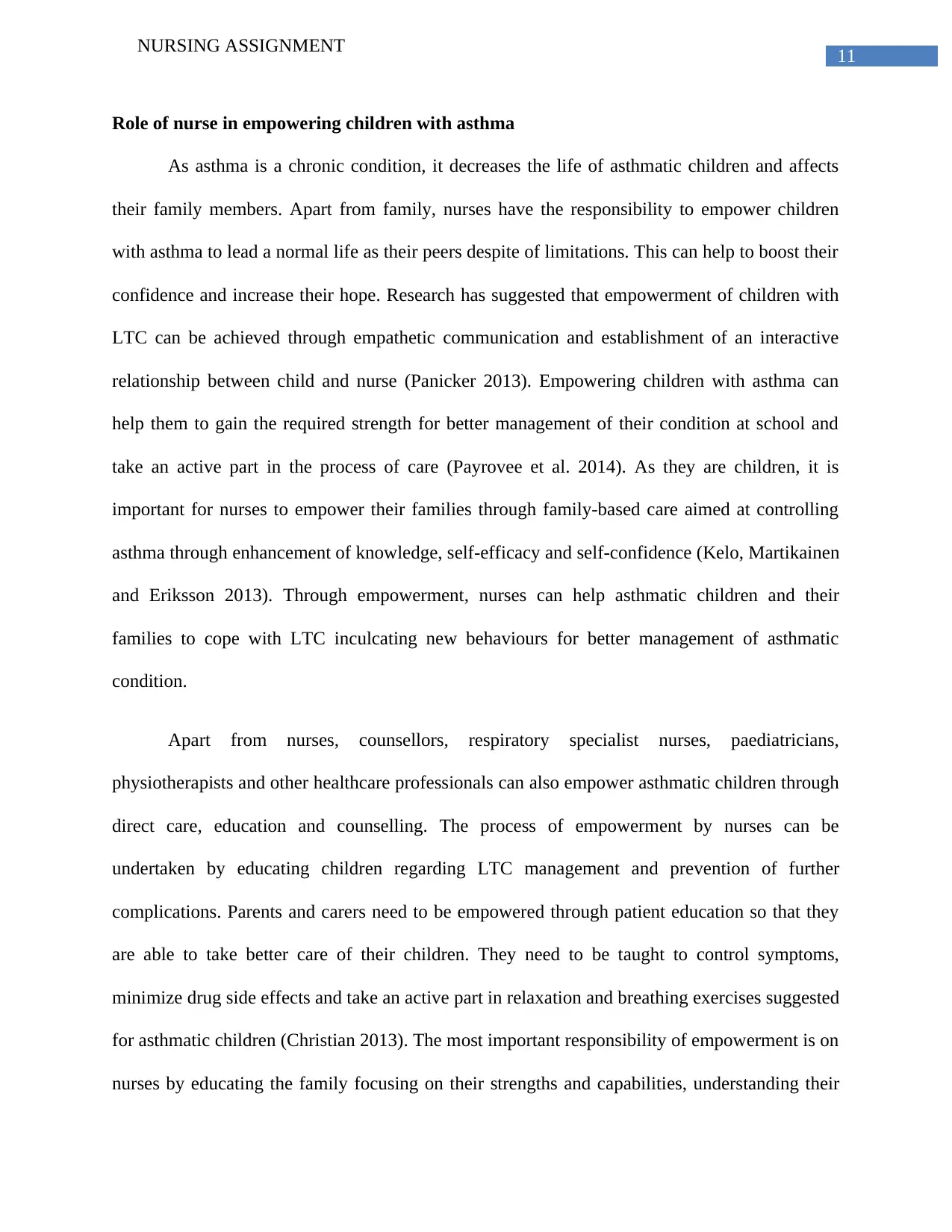
11
NURSING ASSIGNMENT
Role of nurse in empowering children with asthma
As asthma is a chronic condition, it decreases the life of asthmatic children and affects
their family members. Apart from family, nurses have the responsibility to empower children
with asthma to lead a normal life as their peers despite of limitations. This can help to boost their
confidence and increase their hope. Research has suggested that empowerment of children with
LTC can be achieved through empathetic communication and establishment of an interactive
relationship between child and nurse (Panicker 2013). Empowering children with asthma can
help them to gain the required strength for better management of their condition at school and
take an active part in the process of care (Payrovee et al. 2014). As they are children, it is
important for nurses to empower their families through family-based care aimed at controlling
asthma through enhancement of knowledge, self-efficacy and self-confidence (Kelo, Martikainen
and Eriksson 2013). Through empowerment, nurses can help asthmatic children and their
families to cope with LTC inculcating new behaviours for better management of asthmatic
condition.
Apart from nurses, counsellors, respiratory specialist nurses, paediatricians,
physiotherapists and other healthcare professionals can also empower asthmatic children through
direct care, education and counselling. The process of empowerment by nurses can be
undertaken by educating children regarding LTC management and prevention of further
complications. Parents and carers need to be empowered through patient education so that they
are able to take better care of their children. They need to be taught to control symptoms,
minimize drug side effects and take an active part in relaxation and breathing exercises suggested
for asthmatic children (Christian 2013). The most important responsibility of empowerment is on
nurses by educating the family focusing on their strengths and capabilities, understanding their
NURSING ASSIGNMENT
Role of nurse in empowering children with asthma
As asthma is a chronic condition, it decreases the life of asthmatic children and affects
their family members. Apart from family, nurses have the responsibility to empower children
with asthma to lead a normal life as their peers despite of limitations. This can help to boost their
confidence and increase their hope. Research has suggested that empowerment of children with
LTC can be achieved through empathetic communication and establishment of an interactive
relationship between child and nurse (Panicker 2013). Empowering children with asthma can
help them to gain the required strength for better management of their condition at school and
take an active part in the process of care (Payrovee et al. 2014). As they are children, it is
important for nurses to empower their families through family-based care aimed at controlling
asthma through enhancement of knowledge, self-efficacy and self-confidence (Kelo, Martikainen
and Eriksson 2013). Through empowerment, nurses can help asthmatic children and their
families to cope with LTC inculcating new behaviours for better management of asthmatic
condition.
Apart from nurses, counsellors, respiratory specialist nurses, paediatricians,
physiotherapists and other healthcare professionals can also empower asthmatic children through
direct care, education and counselling. The process of empowerment by nurses can be
undertaken by educating children regarding LTC management and prevention of further
complications. Parents and carers need to be empowered through patient education so that they
are able to take better care of their children. They need to be taught to control symptoms,
minimize drug side effects and take an active part in relaxation and breathing exercises suggested
for asthmatic children (Christian 2013). The most important responsibility of empowerment is on
nurses by educating the family focusing on their strengths and capabilities, understanding their
⊘ This is a preview!⊘
Do you want full access?
Subscribe today to unlock all pages.

Trusted by 1+ million students worldwide
1 out of 19
Related Documents
Your All-in-One AI-Powered Toolkit for Academic Success.
+13062052269
info@desklib.com
Available 24*7 on WhatsApp / Email
![[object Object]](/_next/static/media/star-bottom.7253800d.svg)
Unlock your academic potential
Copyright © 2020–2025 A2Z Services. All Rights Reserved. Developed and managed by ZUCOL.





